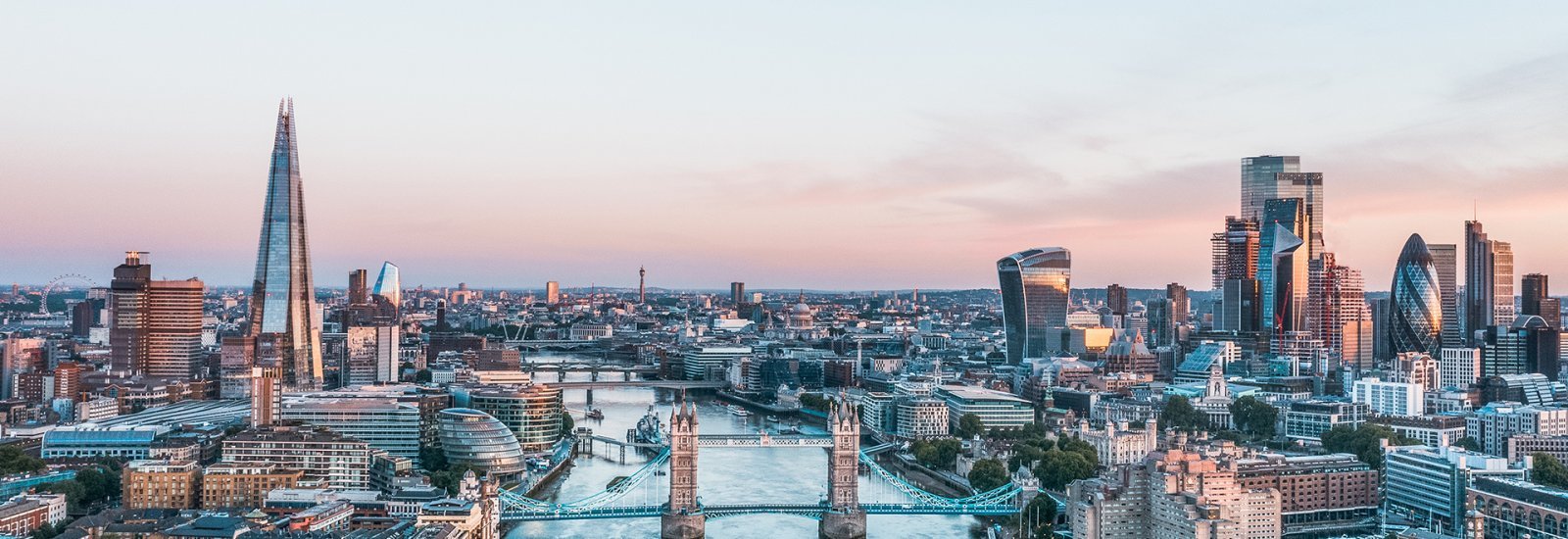In 2019, travel’s last pre-covid year, the most visited cities according to Mastercard’s Global Destination Cities Index were, in order, Bangkok, Paris, and London. Not only have Asian cities like Bangkok risen to the top, but travelers from Asia are ever more important in global tourism. So, Asia-based hospitality chains are expanding, looking to serve both Asian tourists and attract other travelers to their growing number of properties around the world.
Shangri-La, the luxury hotel brand with headquarters in Hong Kong, invited Worth to take part in a top-drawer sampling of trans-Atlantic travel, starting with a taste of British Airways’ new Club Suite business-class cabin from the U.S. to London, two nights each at the Shangri-La properties in London and Paris, with connecting trips via the Eurostar train that links the two cities through the English Channel tunnel. Around the same time, the Canada-based Four Seasons hotel group, well known to luxury travelers in the U.S. with distinctive properties around the world, invited us to their recently opened location on the Chao Phraya River in Bangkok. So we took the opportunity to ponder how Asian hospitality in two great European cities compared with a Western take on luxury in Thailand’s capital.

London
British Airways was the first to offer business-class passengers lie-flat beds, back in 2000. I am really tall, so even some of these lie-flat setups are cramped for me, but this Club Suite one felt roomier, and has a few handy compartments to hold your in-seat essentials (with power ports lodged within). There is also a sliding door between you and the aisle. It does not give you a lot of privacy when sitting up, but when you recline on the bed it gives a sense of being in your own space. In the two decades since BA launched lie-flat seating, competitors such as Qatar Airways have raised the ante on in-flight luxury, and it’s good to see the OG fighting back.
Escorted through Heathrow customs by a BA official, I was whisked away via van to the Shangri-La London, which occupies 19 floors of The Shard, Renzo Piano’s iconic skyscraper–London’s tallest—lies just south of the Thames. I checked in and was taken to my room, which was on the 47th floor.
As I walked in, I was greeted by “Welcome to the clouds!” written by a hotel staff member in white wax pencil on the window. It caught the feeling pretty well. Looking out over the horizon I could see St. Paul’s Cathedral and assorted landmarks stretched out in a rich array. The separate tub and shower had spectacular views over the city, and would seem designed for exhibitionists, except at 47 stories up, who would see? There are shades and curtains for privacy in the room, but I was so entranced by the sights that I left the view unimpeded throughout my stay.

After a cup of afternoon tea, I was at leisure until dinner. I booked a time slot at the pool on the 52nd floor–the highest in Western Europe. Booking a time was necessary. The stretched tetrahedral shape of the Shard means that as one mounts higher, floorplans grow smaller, and the pool on 52 is pretty compact–with more than four or five folks in the water, it hits capacity. But swimming at such a height, with such a view, is marvelous.
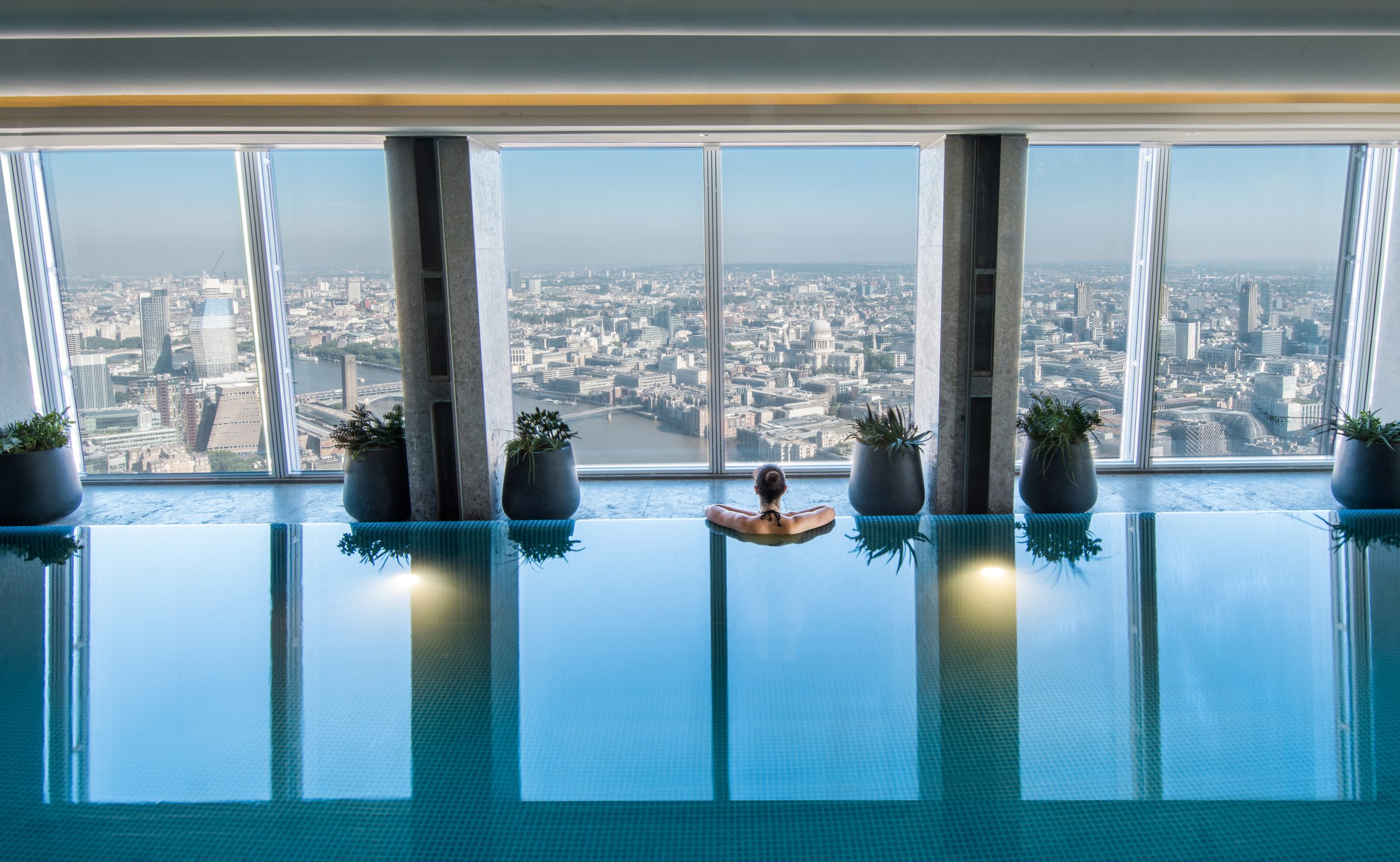
Back in my room, I began to take note of the various Asian touches to the decor. Over the desk there was a lovely framed calligraphic brush stroke, and cherry-blossom branches adorned the wallpaper in the alcove behind the bed. But it was soon time to proceed back to the 52nd floor, this time for a light dinner and drinks at GŎNG–the “highest hotel bar in Western Europe,” according to the cocktail menu. That menu continues the eastern theme, with drinks “Inspired by an Ancient Treasure Ship in the Fleet of Admiral Zheng He” (the menu is an enthusiastic employer of capital letters). The sushi, strips of Wagyu beef, dumplings, etc. were excellent, as were the drinks I kept savoring with the nighttime view. It differed from the one in my room, with the glorious sight of the HMS Belfast, a World War 2 cruiser that is part of the Imperial War Museum, brightly illuminated far below at its mooring on the Thames.
The next morning, we experienced a private, behind-the-ropes tour of the Tower of London with a Yeoman Warder of the Guard, including a chamber containing a late 14th-century mural, and the room where Thomas More was imprisoned in 1534. Next stop was Borough Market, where Shangri-La chef Scot Paterson led us through the assortment of vegetable vendors, cheesemongers, and more. My attention was drawn to the nearby Bread Ahead Bakery, which offered an enticing array of donuts, but we were on the way to lunch at Berenjak, a local Persian restaurant, and figured we would stop there afterwards. Lunch was lovely, with savory flatbreads and richly seasoned dishes, but on our way back past Bread Ahead the sparse crowds of pre-lunch had been replaced by a long queue, so we skipped the donuts.
The afternoon options included the Cézanne show at the Tate Modern. American collectors were enthusiastic about Cézanne, so anyone who has spent time in the great museums of Chicago, New York, Philadelphia, and Boston will have encountered some of these pictures before. But seeing them hung in different surroundings, with different works adjacent, invited new responses. Returning to the Shard, I soon heard a knock on my door, and a member of the Shangri-La staff handed me a box containing two Bread Ahead donuts. Reader, I ate them.
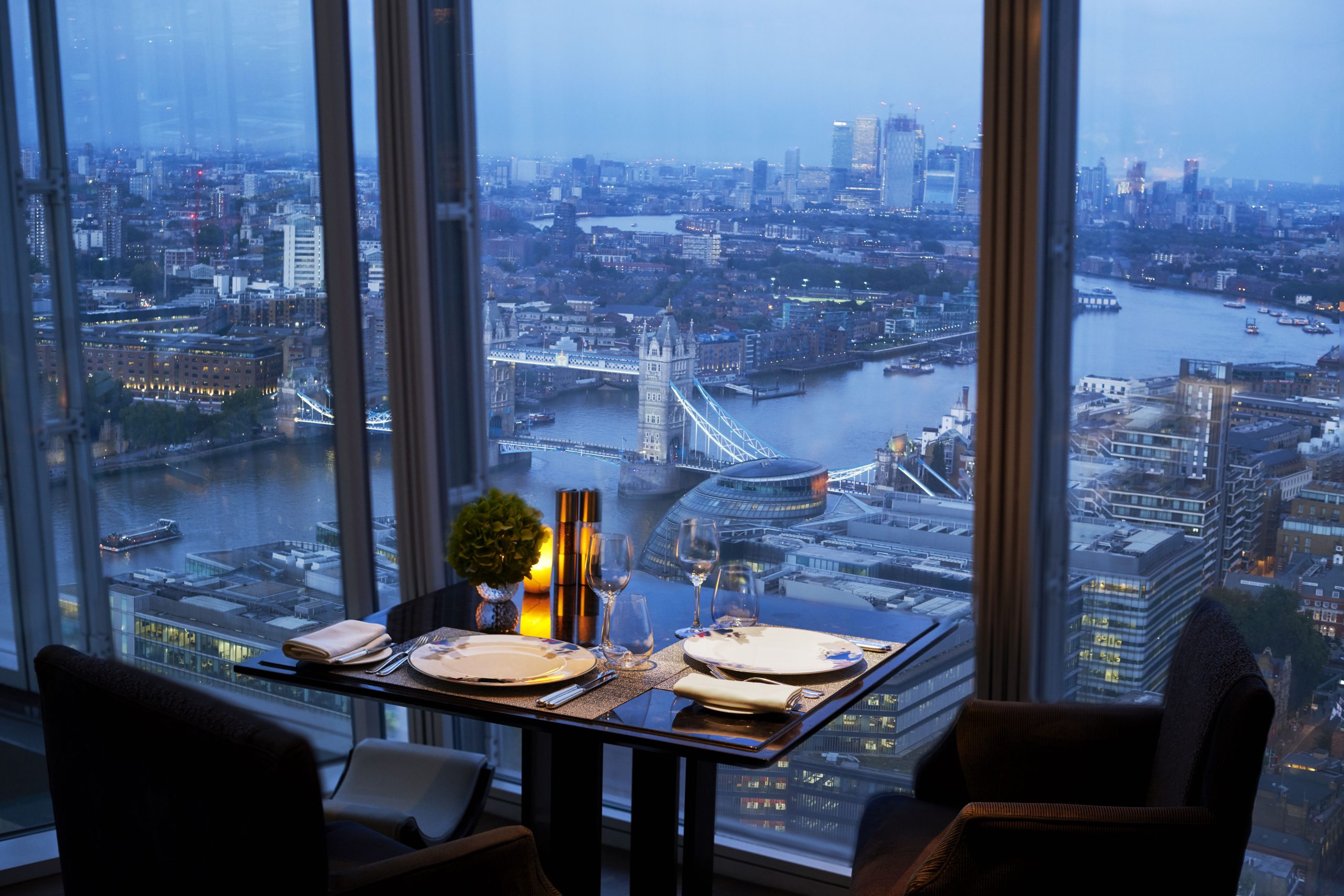
The London stay ended with a multi-course meal at Ting, the flagship restaurant of the Shangri-La London, with the hotel’s general manager, Kurt Macher. The sommelier’s wine pairings played against expectations and sprang surprises, such as an excellent English pinot noir from Hush Heath Estate and a powerful Cabernet (paired with the Wagyu beef entree), a 2016 Château Changyu Moser XV, from northwestern China. Again, the Asian touch was unforced and harmonious.
All one could think after this was, If this is London, what does Paris hold in store?
Paris
The Eurostar trip through the Chunnel is easy and quick–about two and a half hours. The business-class experience is even finer, particularly the lounges. In Paris, the lounge seems to be run by obsessively neat staff, with the beverage cans and bottles arrayed so neatly that you exercise precision as you extract your soda or mineral water.
If the Shangri-La at The Shard presented a very 21st-Century kind of luxury, the Paris version is of the Belle Époque variety. The core of the hotel was built in the 1890s as the mansion of Roland Bonaparte, a grand-nephew of Napoleon who married well (his wife’s fortune was founded in part upon the Monte Carlo Casino) and devoted his time and a good bit of his fortune to the study of botany. The hotel’s entrance, framed by Ming Dynasty vases, establishes the East-meets-West mood. The lobby and surrounding rooms display Asian art and ceramics, old and new, and the combination of 19th-century French interiors and Asian art succeeds admirably.
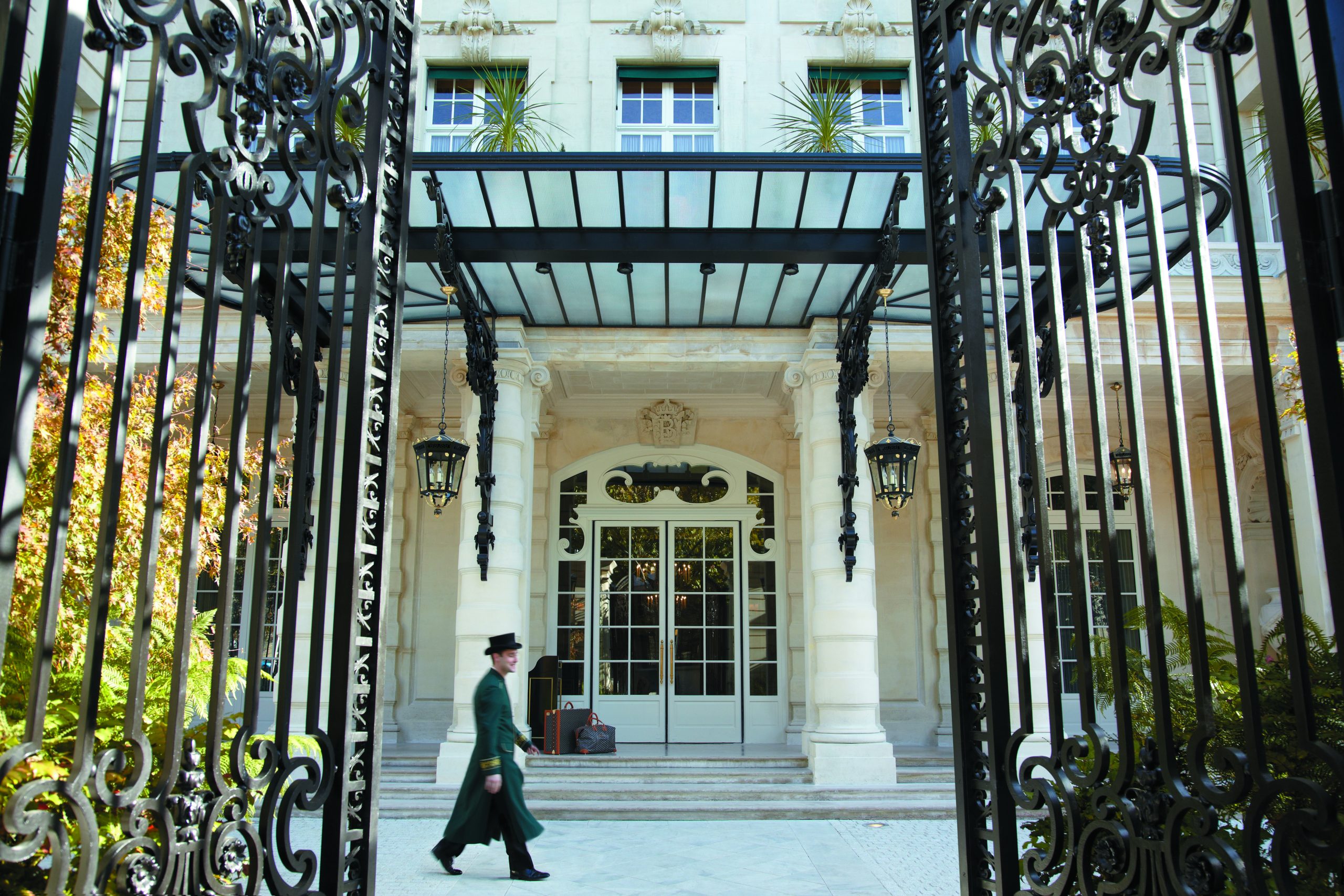
The hotel is a short stroll from the Seine in the 16th Arrondissement, and when I entered my fifth-floor room and went to the French doors out to my small balcony, I saw the Eiffel Tower rising just across the river. The elegant public rooms of the hotel were built as reception halls and family sitting rooms for Prince Roland. The art includes a bronze frieze on a fireplace mantel depicting the 18th Brumaire—the coup by which Napoleon established himself as First Consul in 1799. The title “consul” was taken to invoke the glory of the Roman Empire in the service of the nascent French one, and another of the public rooms is adorned with a Pompeiian-style painted border.
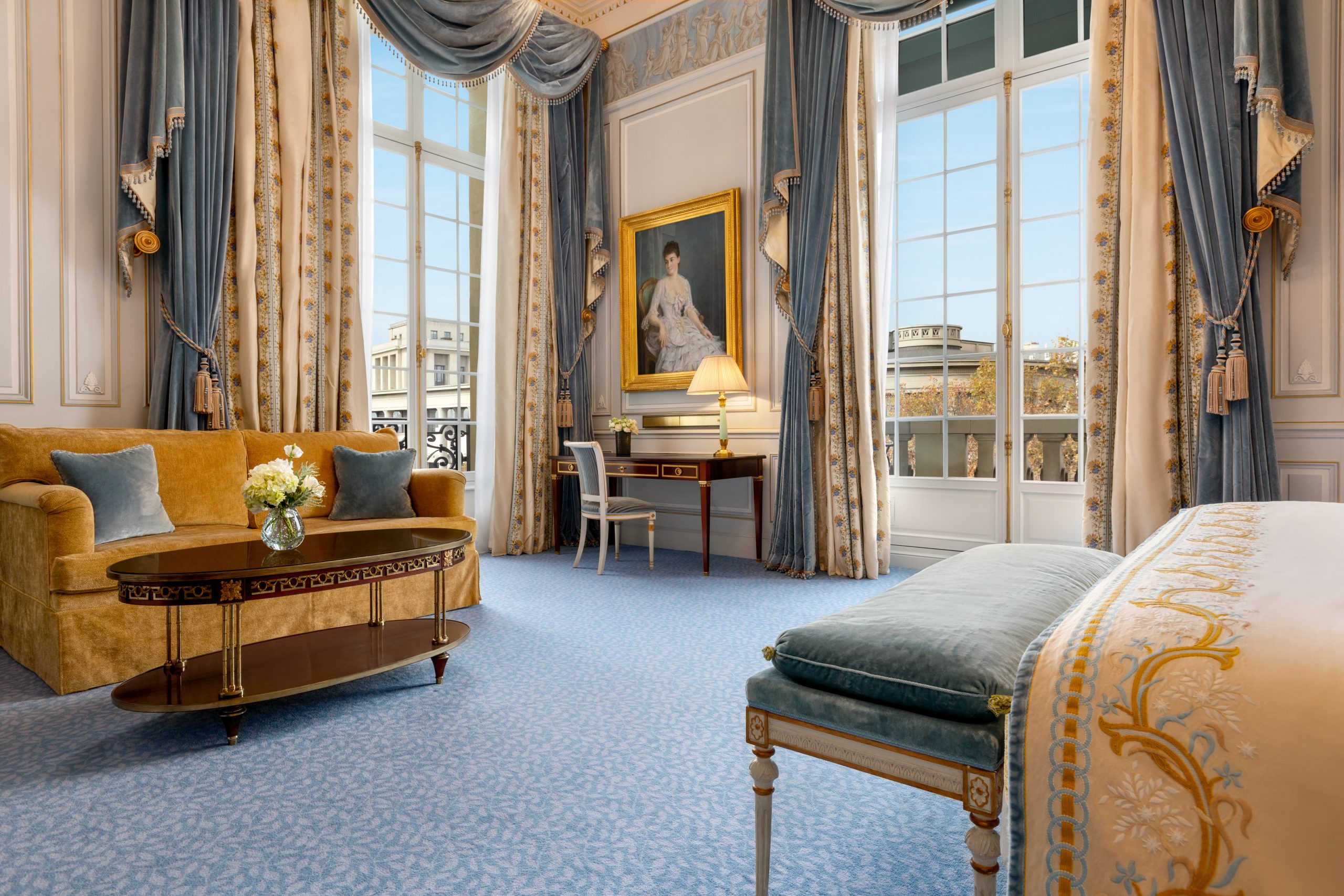
So it was with a jumble of imperial visions, Roman and French, that I descended to the Shangri-La’s basement for my next appointment, a CBD oil massage at the spa. Until that moment I had paid little attention to the supposed therapeutic powers of CBD. I can only say that it was the finest massage I have ever experienced. Maybe it was the skills of the masseuse, maybe the CBD, but it was exquisite.
The next stop on the agenda was a buffet dinner on the terrace of the Shangri-La Suite, a €20,000 a night accommodation with a vast terrace overlooking the Seine to the south and, to the east, the house in which Gustave Eiffel lived while constructing his eponymous tower. One of the hosts set the tone for the evening by using a saber to open a bottle of champagne, and delicacies were provided by a variety of talents at the hotel, including Chef Samuel Lee Sum, executive chef at the hotel’s Michelin-star Chinese restaurant, Shang Palace, and pastry chef Maxence Barbot.
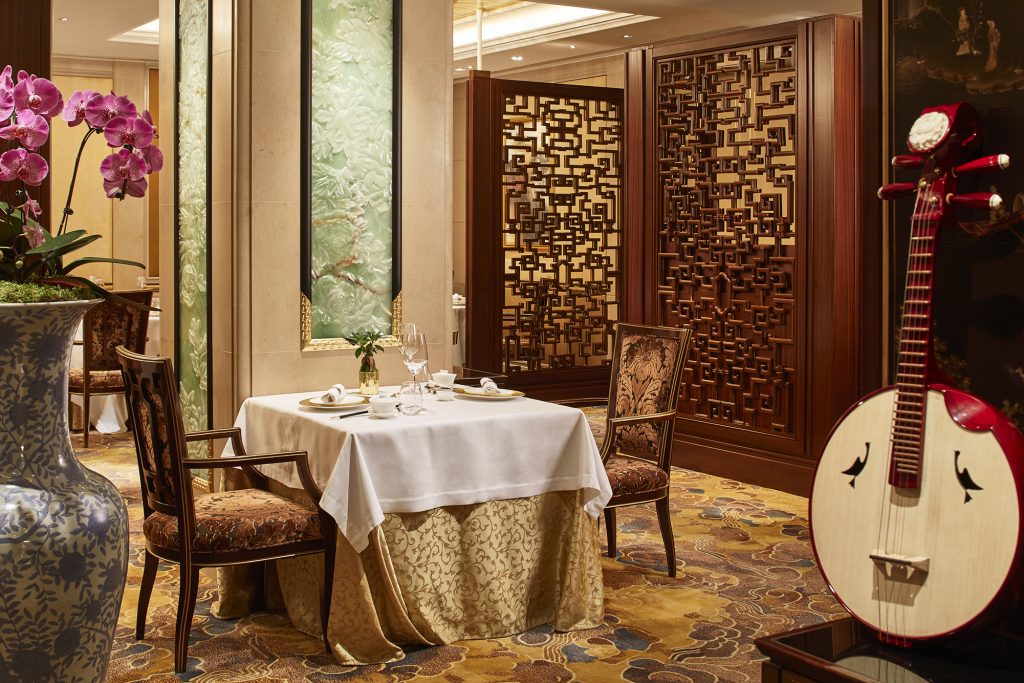
The next morning was devoted to a visit to the museum of the Fondation Louis Vuitton. There, in the great Frank Gehry edifice on the edge of the Bois de Boulogne, was a retrospective of the American painter Joan Mitchell on one floor, with most of the space on the floors above given over to more of her paintings hung beside works by Claude Monet. Mitchell (1925-1992) was involved in the early days of Abstract Expressionism in New York but later moved to France, where Monet’s work was a significant point of reference for her own work. Seeing Mitchell’s work and Monet’s together, I found myself connecting the (Impressionist) dots back to the Cézanne show I had seen in London.
The last night in Paris got underway at the Shangri-La’s Bar Botaniste, a cozy, elegant room that pays homage to Prince Roland’s scientific activities. The science practiced there today is mixology, with head barman Pierre-Marie Bisson delivering both the classics and his own variations on classic themes: I tried his variation of a Rusty Nail, called a Dufftown Funk, which combined 21-year-old Glenfiddich with Benedictine, a white wine aperitif, dark rum, and Cajun spices. Although I am theologically opposed to blending 21-year-old single malt with anything except a splash of water, this was a spectacular concoction.
Then, feeling like a contestant on some sybaritic version of The Amazing Race, it was on to the new restaurant Omar Dhiab, which takes its name from its owner, who had been a chef at the Shangri-La Paris before leaving to start his own. The spare elegance of the interior allows the food to take the spotlight. Each course is delivered with style and grace, paired with an appropriate wine, and all are designed to delight the eye as well as the palate. As we left, one of our party was approached outside the restaurant by a local, who turned out to be a restaurant critic. How, she wanted to know, had a group of Americans found their way to this hot new Parisian boîte? “Our hotel, the Shangri-La, arranged it,” she was told.
The next morning we made our way through the Gare du Nord, on to London, out to Heathrow, and back to the comforts of the British Airways Club Suite. Three days later, I was leaving New York again, this time for Bangkok.
Bangkok
Having experienced Asian-accented hospitality in London and Paris, I was wondering how the new Four Seasons Bangkok at Chao Phraya River would express Continental luxury in an Asian city. Flying to Bangkok from New York is a far more lengthy process than nipping over to London. But denial is the best medicine for jet lag, I figured, and on the way in from the airport to the hotel I had seen that the Thailand Museum of Modern Art had a show on by the British street artist Banksy. So, when I arrived, I accepted the kind offer of a ride and a guide to the show. (There is also an outpost of this museum at the Four Seasons.)
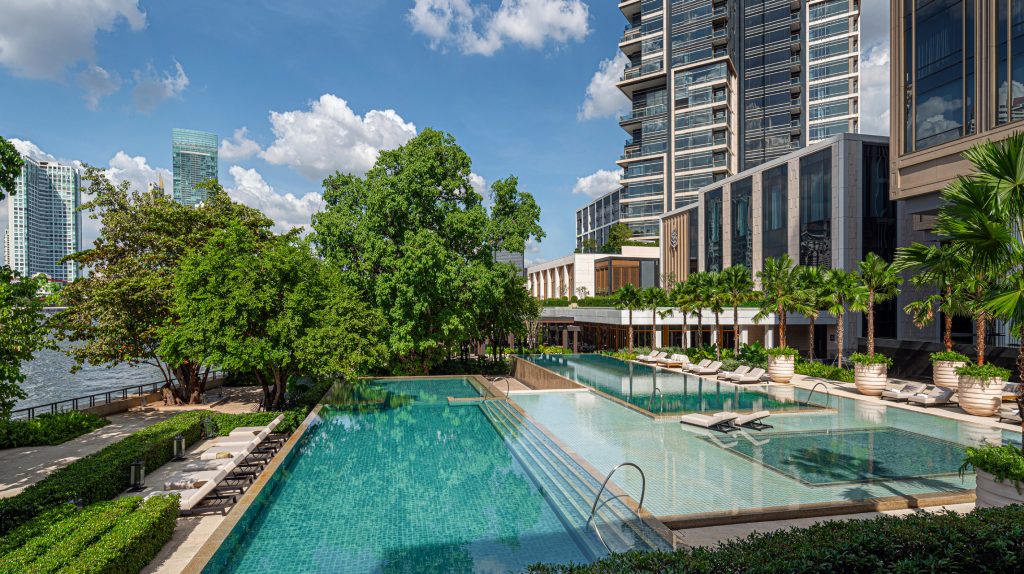
But before heading out I went to my room to wash up after the flight. I was feeling pretty spoiled after the rooms and views I had had in London and Paris, but the Four Seasons was up to the challenge. My room, overlooking the river, was (like all the rooms there) high-ceilinged, and furnished in a largely grey and earth-tone palette, understated and elegant. The art in the room was confined to vases of various sizes and shapes—again muted in color. The entire effect was like a page out of the Restoration Hardware catalog, but in a good way. This interior self-effacement directs your attention to what is happening outside the window–the ceaseless river traffic up and downstream, the city skyline, and the elegant layout of the Four Seasons itself.
On my way to the Banksy exhibit, I had my introduction to Bangkok traffic. Like other cities with a long history, Bangkok was built up before the advent of the automobile, so traffic can be epic. Efforts are now underway to give the city the mass transit infrastructure it needs, but much remains to be done. The traffic, though heavy, was moving, and the Banksy show, with its politically engaged street art, was thought-provoking and apt for this city–it turns out that Bangkok has many indigenous examples of street art.
I headed back to the hotel for dinner in my room. The table was set with a view over the river, and the superb light dinner was inspired by Thai street food. Turning in, I left the curtains open and fell asleep to the parade of neon-lit party boats and ferries passing by like bioluminescent denizens of the ocean’s depths.
The Four Seasons folks describe their Bangkok property as an urban resort, and it’s an accurate description. The riverside site covers nine acres, which the hotel shares with a high-rise tower of luxury apartments. The hotel’s lead designer was Jean-Michel Gathy, who has done the same duty for other Four Seasons properties and many other leading hotels and resorts. The hotel offers a spa and a variety of exercise opportunities, including a large and fully equipped gym, yoga classes, and training in the proudly Thai art of Muy Thai–kickboxing. I opted for a Thai massage, which is performed while one is wearing loose pajamas; the fabric provides grip to stimulate muscles and sinews.
A fuller exploration of the hotel’s dining options began that evening with drinks and a light dinner at BKK/Bangkok Social Club, an elegant setting with brown leather upholstery, low tables, and a serious drinks menu. The space is meant to evoke the elegant nightlife of old Buenos Aires, according to the room’s impresario, beverage manager Philip Bischoff. Modern takes on classic cocktails can be a bit labored, but the ones here were mixed and presented with restraint—no glass-dome-filled-with-smoke theatricality.
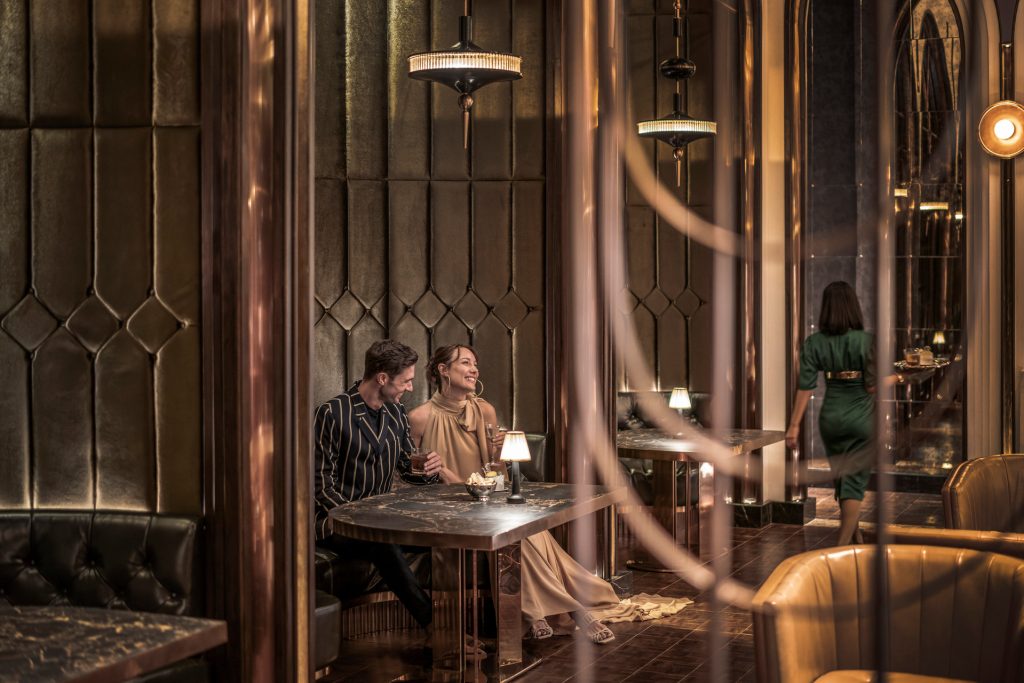
One rule to follow when you spend an evening downing cocktails: first, check what’s on your calendar for the next morning. For me, it was a 7 a.m. Muay Thai class. The hotel had thoughtfully provided a personalized kickboxing uniform, but looking the part does not equal feeling it. After some warmups and some fundamental instruction, I had a few chances to do two minutes in the ring with the instructor. Let me be clear—the teacher was not striking back: all I had to do was rain down punches and kicks on him. With a timer counting down, I started punching and kicking, trying my best to put some power behind the blows as the instructor held up strike pads as targets. By the 90-second mark, I was ready to tap out, but pride kept me going. By the end of the session, I was sure that I had purged whatever “signature cocktails” were still lingering in my veins.
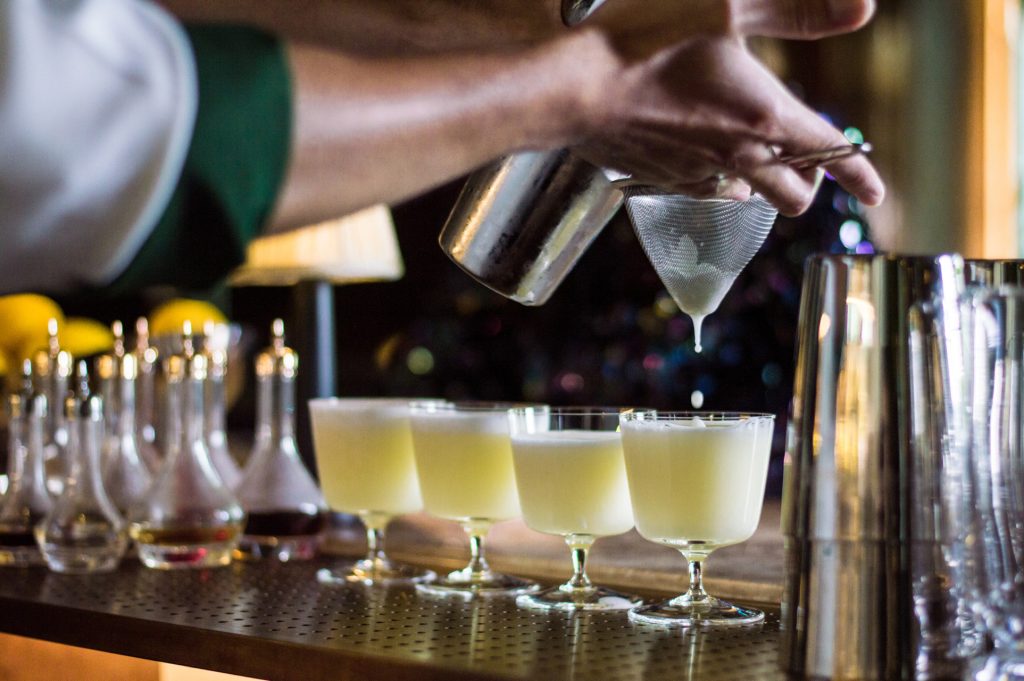
The rest of the morning was devoted to a walking tour of the city’s recently established “creative district,” home to an engaging collection of retail shops as well as art galleries and restaurants. To get us there, the hotel had summoned a small detachment of tuk-tuks–brightly decorated motor tricycles with a covered seat in the back for one (larger) or two (smallish) passengers. Ideally suited for moving expeditiously through the swirling Bangkok traffic, and negotiating the smaller alleyways that branch away from the main streets, the tuk-tuks were a colorful way to traverse the bustling city. Along the route, street vendors were hawking cans of soda, grilled meats, bags of nuts, fresh fruit, knick-knacks, etc. Street art emblazoned on walls reinforced that “creative district” label.
I was looking forward to the evening’s main event, dinner at Yu Ting Yuan, the Four Seasons’ flagship Cantonese restaurant, which was awarded one star by Michelin less than a year after it opened. The meal was a sustained procession of excellence. Pork belly with mustard barbecued pork, hot and sour soup with crabmeat, deep fried prawns of surpassing lightness, Chilean sea bass, wok-fried beef with morels, diced duck, shrimp wonton noodles—by the time the rice-dumpling-with-almond-cream dessert arrived, I was bursting with contentment.
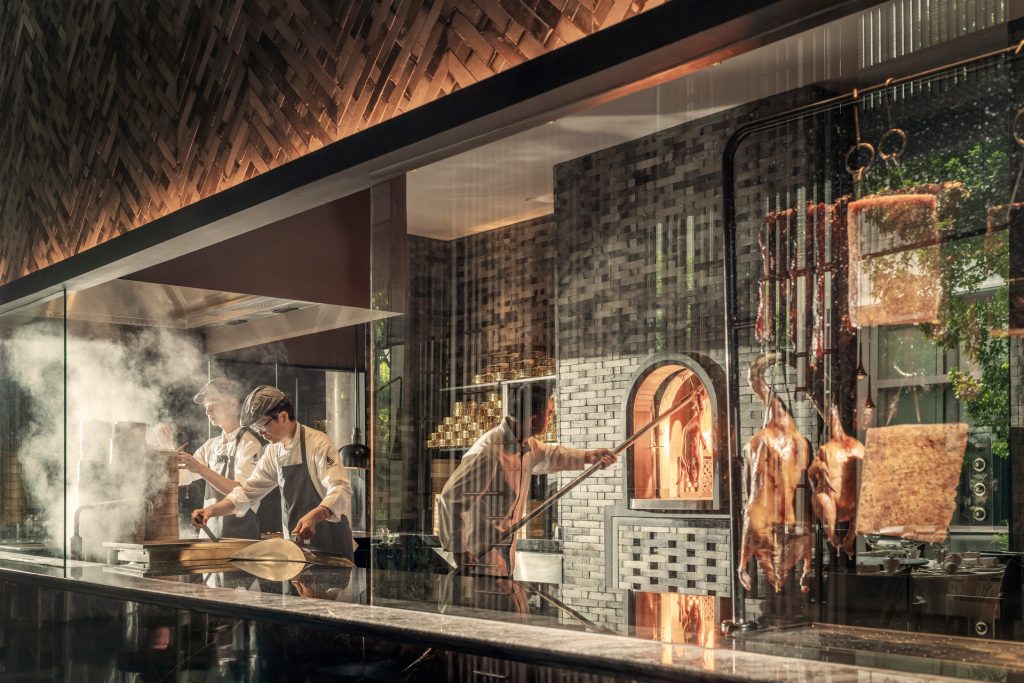
The next morning it was time to explore Kudeejeen, Bangkok’s Portuguese neighborhood. The Portuguese were the first European traders to do business in Siam, starting in the early 16th century. They were given permission to build a Catholic church, and the Portuguese settlers introduced some of their own culinary traditions to Bangkok. I enjoyed a sweet khanan farang kudi chin, which loosely translated means “foreigner cake,” one of the most popular of Portugal’s contributions to Thai cuisine.
The following morning I had a strong cup of coffee at Cafe Madeleine, a bit of Paris transplanted to the banks of the Chao Phraya. The Parisian theme continued with lunch at Brasserie Palmier, the hotel’s seafood-forward brasserie. (The hotel’s employees often grab their own lunches outside the hotel at one of the many nearby street-food stands, while the French and Italian offerings at its restaurants attract a sizable local Thai clientele.)
The main gustatory event of the day was still ahead. Dinner that night was at Lahnyai Nusara, an exclusive 14-seat restaurant with a prix fixe tasting menu that I counted as having 16 courses (shared around the table), divided into Teasers, Prelude, Main Act, and Happy Ending. The chef, Thitid “Ton” Tassanajohn, borrows ingredients and techniques from a variety of cuisines, and has, to put it mildly, a generous hand with truffles. Both the food and the presentation were faultless.
The next morning it was off to the airport for the long journey home, fortified by a welcomed to-go package of road food from the Four Seasons.
So after trips to experience Asian-inflected elegance in London and Paris, and Continental luxury on the banks of the Chao Phraya River, what is learned? If there is a common characteristic that luxury provides, it is attentiveness. In Bangkok, even the tiniest details were thought of–if you want milk in your in-room coffee or tea, there is a small carton in the fridge, along with a tiny pair of scissors that allows you to snip off a corner of the sippy-pack container easily. At the Shangri-La in Paris, at dinner on the terrace, a bottle of Macallan was there in case I wanted some–it having been noted that I ordered it at the bar at Gong in the Shard. The staff at all three hotels are eager to help visitors discover the resources of the hotel and the delights of the surrounding city.
Luxury at this level is about more than the thread count of the sheets and the softness of the towels. It is about making the guest feel like exactly that–a guest: neither a customer nor a friend, but someone to whom hospitality is owed as an aspect of simple humanity. Of course, one is a customer, and the hotel staff are doing a job. But at its best, hospitality becomes less about obligation and more about courtesy.
Courtesy, like cuisine, takes different forms in different cultures. But both at the Shangri-La hotels in London and Paris, and at the Four Seasons Bangkok, courtesy, when pursued with passion, proves itself to be a universal language.

